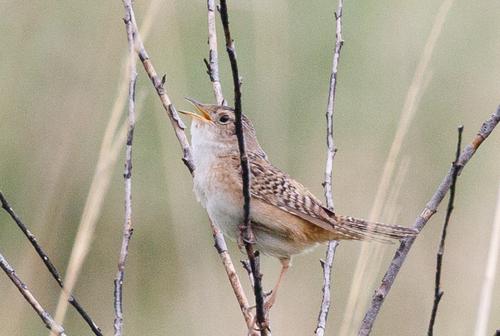Plants and Animals
Cistothorus platensis Sedge wren
Key Characteristics
Sedge wrens are a small wren, overall brown with streaky patterns of black, white and gray. Underparts fade from tawny or buff at the sides to whitish on the belly. White streaking on crown and back. Male and female plumage identical, with first year birds similar to adults. Quite like the marsh wren (Cistothorus palustris) in appearance and behavior, but distinguishable by song, size, and bill length. While both species occur in wet or marshy areas, the sedge wren tends to avoid areas with deeper water and cattails which the marsh wren prefers.
Status and Rank
US Status: No Status/Not Listed
State Status: SC - Special Concern (rare or uncertain; not legally protected)
Global Rank: G5 - Secure
State Rank: S3 - Vulnerable
Occurrences
| County | Number of Occurrences | Year Last Observed |
|---|---|---|
| Chippewa | 1 | 2023 |
| Crawford | 1 | 2024 |
| Huron | 1 | 2019 |
| Kalkaska | 2 | 2025 |
| Washtenaw | 1 | 2025 |
Information is summarized from MNFI's database of rare species and community occurrences. Data may not reflect true distribution since much of the state has not been thoroughly surveyed.
Habitat
Sedge wrens inhabit wet, herbaceous meadows, grasslands, and vegetation along the margins of marshes and lakes. They display a preference for areas with abundant standing dead vegetation, and tall herbaceous plants, in areas not dominated by cattails.
Natural Community Types
For each species, lists of natural communities were derived from review of the nearly 6,500 element occurrences in the MNFI database, in addition to herbarium label data for some taxa. In most cases, at least one specimen record exists for each listed natural community. For certain taxa, especially poorly collected or extirpated species of prairie and savanna habitats, natural community lists were derived from inferences from collection sites and habitat preferences in immediately adjacent states (particularly Indiana and Illinois). Natural communities are not listed for those species documented only from altered or ruderal habitats in Michigan, especially for taxa that occur in a variety of habitats outside of the state.
Natural communities are not listed in order of frequency of occurrence, but are rather derived from the full set of natural communities, organized by Ecological Group. In many cases, the general habitat descriptions should provide greater clarity and direction to the surveyor. In future versions of the Rare Species Explorer, we hope to incorporate natural community fidelity ranks for each taxon.
Management Recommendations
Protect, maintain, and restore occupied wet meadow and mesic grassland habitat. Vegetation management activities (mowing, controlled burns, and brush clearing) are recommended to set back succession and maintain habitats, but these activities should be conducted in the fall (Oct and Nov) after migration. All areas of suitable habitat should not be disturbed in a single season. Burning or mowing of habitats should occur on a rotational basis, ideally every 3-6 years, to create a diversity of cover types and provide undisturbed patches of habitat for nesting. Undisturbed habitats adjacent to recently burned areas may provide important sources of litter for nesting material. Herbicide and insecticide applications should be avoided during the nesting season. Sedge wren may benefit from the retention of moderate amounts of shrubs, but shrub cover should not exceed 15%.
Management Avoidance Period: From first week of May to last week of August
Active Period
Migration from fourth week of April to first week of June
Migration from first week of August to fourth week of October
Nesting from fourth week of May to third week of August
Survey Methods
Surveys for this species are typically point counts or transects through suitable habitat during the breeding season. Sedge wrens are vocal throughout the day but sing at higher rates near dawn. Males most often sing perched on a high stem or branch, just above the grass canopy.
Point count, transect
Survey Period: From fourth week of May to fourth week of July
Time of Day: Morning (sunrise)
References
Survey References
- Bibby, C.J., N.D. Burgess, and D.A. Hill. 1992. Bird Census Techniques. Academic Press, New York.
Technical References
- Herkert, J. R., D. E. Kroodsma, and J. P. Gibbs. 2021. Sedge Wren (Cistothorus stellaris), version 1.0. In Birds of the World (A. F. Poole and F. B. Gill, Editors). Cornell Lab of Ornithology, Ithaca, NY, USA.
- Ng, A. M. B., and A. P. Kortenhoven. 2025. Species Abstract for Cistothorus platensis (sedge wren). Michigan Natural Features Inventory, Lansing, Michigan, USA.


